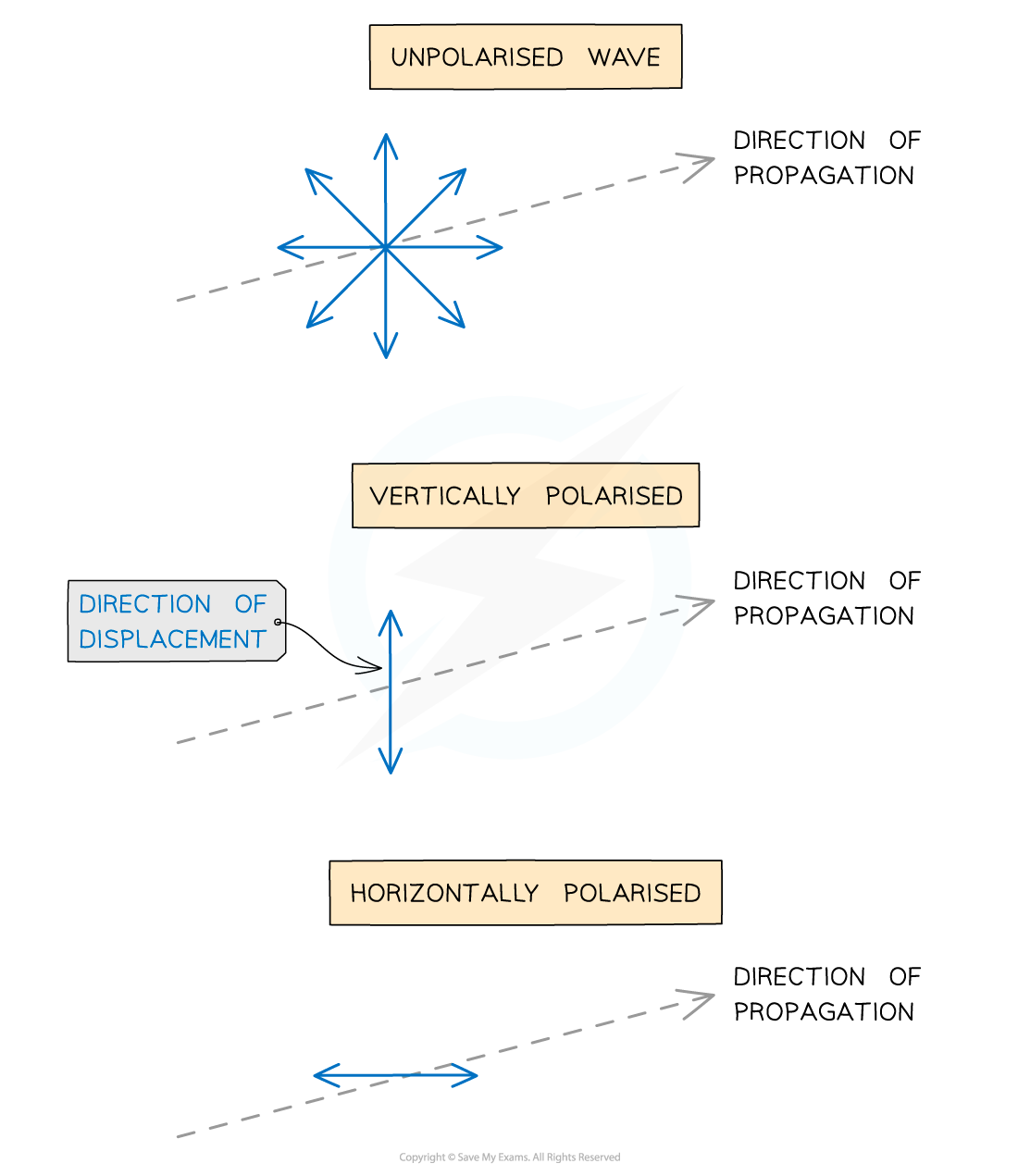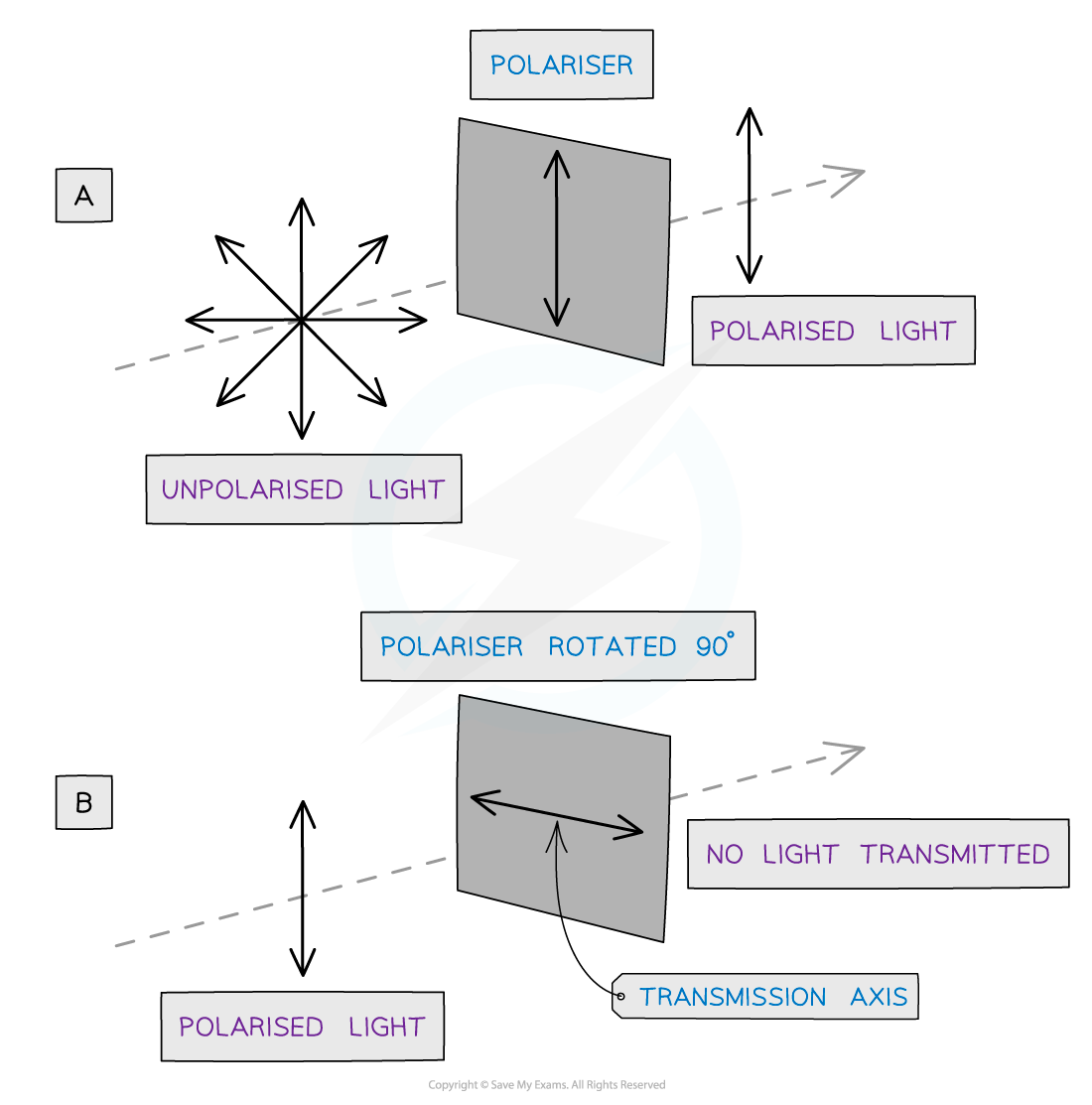Polarisation (AQA A Level Physics) : Revision Note
Did this video help you?
Polarisation
Polarisation is when:
Particle oscillations occur in only one of the directions perpendicular to the direction of wave propagation
Polarisation can only occur in transverse waves
This is because transverse waves oscillate in any plane perpendicular to the propagation direction
When transverse waves are polarised, this means:
Vibrations are restricted to one direction
These vibrations are still perpendicular to the direction of propagation / energy transfer
The difference between unpolarised and polarised waves is shown in the diagram below:

Diagram showing the displacement of unpolarised and polarised transverse waves
Longitudinal waves (e.g. sound waves) cannot be polarised
This is because they oscillate parallel to the direction of travel
Waves can be polarised through a polariser or polarising filter
This only allows oscillations in a certain plane to be transmitted

Diagram showing an unpolarised and polarised wave travelling through polarisers
Diagram A shows:
Only unpolarised waves can be polarised
Diagram B shows:
When a polarised wave passes through a filter with a transmission axis perpendicular to the wave, none of the wave will pass through
Light can also be polarised through reflection, refraction and scattering
Investigating Light Intensity with Two Polarisers
If an unpolarised light source is placed in front of two identical polarising filters, A and B, with their transmission axes parallel:
Filter A will polarise the light in a certain axis
All of the polarised light will pass through filter B unaffected
In this case, the maximum intensity of light is transmitted

When both polarisers have the same transmission axis, the intensity of the transmitted light is at its maximum
As the polarising filter B is rotated anticlockwise, the intensity of the light observed changes periodically depending on the angle B is rotated through
When A and B have their transmission axes perpendicular to each other:
Filter A will polarise the light in a certain axis
This time none of the polarised light will pass through filter B
In this case, the minimum intensity of light is transmitted

When one of the polarisers is rotated through 90°, the intensity of the transmitted light drops to zero
The resulting graph of the light intensity with angle, as the second polariser is rotated through 360°, looks as follows:

Graph showing how the intensity of the transmitted beam varies with the angle between the transmission axes of the two polarisers
In real life, the intensity of the unpolarised electromagnetic wave reduces after it passes through a polarising filter
Worked Example
Which statement below describes a situation in which polarisation should happen?
A. Radio waves pass through a metal grid
B. Surface water waves are diffracted
C. Sound waves are reflected
D. Ultrasound waves pass through a metal grid
Answer:
Radio waves are transverse waves - they can be polarised by a metal grid so only the waves that fit through the grid will be transmitted, therefore, A is correct
B cannot be correct as waves are not polarised when diffracted, but are polarised only when reflected, refracted or scattered
C & D cannot be correct as polarisation only occurs for transverse waves, therefore, C & D can be ruled out as sound and ultrasound are both longitudinal waves
Examiner Tips and Tricks
You may be expected to describe the intensity, or even draw the graph of intensity v angle, for light with two polarisers, however, the good news is that you won't be expected to perform any calculations (Malus's Law) in relation to this.
Applications of Polarisers
Polaroid Sunglasses
Polaroid sunglasses are glasses containing lens with polarising filters with transmission axes that are vertically oriented
This means the glasses do not allow any horizontally polarised light to pass through

Polaroid sunglasses contain vertically oriented polarising filters which block out any horizontally polarised light
When light is reflected from a reflective surface e.g. the surface of water or a wet road, it undergoes partial plane polarisation
This means if the surface is horizontal, a proportion of the reflected light will oscillate more in the horizontal plane than the vertical plane
Therefore, polaroid sunglasses are useful in reducing the glare on the surface of the water (or any reflective surface) as the partially-polarised light will be eliminated by the polarising filter
As a result of this, objects under the surface of the water can be viewed more clearly

When sunlight reflects off a horizontal reflective surface, such as water, the light becomes horizontally polarised. This is where polaroid sunglasses come in useful with their vertically aligned filter
Polaroid Photography
Polaroid cameras work in the same way as polaroid sunglasses
They are very useful for capturing intensified colour and reducing glare on particularly bright sunny days
Polarising filters also enable photographers to take photos of objects underwater
This is because the light reflected on the surface of the water is partially polarised in the horizontal plane
This glare is eliminated by the polarising lens
However, the light from the underwater object is refracted by the surface of the water, not reflected, so it is not plane-polarised
Therefore, the light from the underwater object is more intense than the glare and shows up much more brightly in the photo

As well as giving a cool look to photographs, polaroid filters are extremely useful for reducing glare in photos and snapping pictures of objects underwater
Polarisation of Radio & Microwave Signals
Radio and television services are broadcast either horizontally-polarised or vertically-polarised
Therefore, the reception aerial needs to be mounted flat (horizontal), or on its side (vertical),
The particular orientation of an aerial will depend on the transmitter it is pointing towards and the polarity of the services being broadcast

Broadcasting towers always transmit either vertically or horizontally polarised signals. This is why aerials must be positioned accordingly otherwise they won't pick up the TV signal correctly

You've read 0 of your 5 free revision notes this week
Sign up now. It’s free!
Did this page help you?
